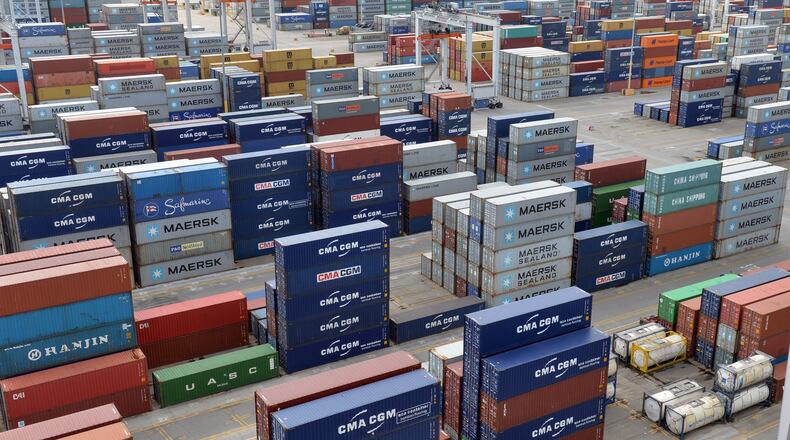If you want to understand the state of the economy, both the good and the bad, Savannah’s port offers a vivid snapshot.
The queue of 22 ships waiting to unload Monday signaled strong demand for goods and the scramble by retailers to stock up as the holiday season approaches.
But the nautical backlog — virtually non-existent a few months ago — was also a warning that consumers could see shortages and higher prices, according to supply chain experts.
A few months ago, the port was busy enough, but there were often no ships waiting, said Griff Lynch, executive director of the Georgia Ports Authority. “In the spring, it was nothing like this.”
In August, the Port of Savannah had its second-busiest month on record, handling 485,595 containers. That was 10% higher than the same month a year ago, which was then a record for August.
About 65% of containers passing the port are imports bound for American companies and consumers. Much of the demand now is pegged to the approaching holidays.
But moving all of that cargo isn’t easy. Many other U.S. ports also are backed up. At the giant West Coast ports of Los Angeles and Long Beach, more than 60 ships have been lined up at times this month, part of an unprecedented global bottleneck in moving goods.
When ships and trucks and people have to wait, the whole system becomes less efficient and more costly.
“The backlogs and delays in ports are very worrisome,” said Pinar Keskinocak, a professor in Georgia Tech’s Stewart School of Industrial and Systems Engineering.
With the overall economy growing, incomes up for most people, and discretionary travel still subpar, there is a lot of money for holiday buying, economists say.
Despite a still-uncontrolled coronavirus, many retailers are betting on a robust holiday season — and that means trying to stock up in advance. But those efforts are complicated since the world’s supply chain is still struggling to rebalance itself after repeated disruptions more than 18 months into a pandemic.
One of the casualties is “just in time” inventories — the pre-pandemic practice in which businesses kept little stock on hand to keep costs down and were able to quickly replenish that stock as needed.
“We used to have an efficient system where everything on the supply chain was synchronized,” said Nikolay Osadchiy, an associate professor who teaches supply chain management at Emory’s Goizueta Business School. “Right now, it’s not predictable at all.”
The rush to stock up has its own danger, Osadchiy said.
What if retailers buy the wrong goods? What if each of their efforts adds up to too much buying? That could mean dropping prices, layoffs and more disruption in the supply chain.
The past few months, the highest-profile shortage has been in production of vehicles, which cannot get enough of the silicon chips used in the on-board computers. That scarcity has meant shutdowns in auto assembly plants, including the massive Kia plant in West Point.
This holiday’s shortages are least likely in products made in the United States, said Osadchiy. Among foreign-made goods, the most likely shortages are in goods that depend on silicon chips.
“With the more complex toys and electronics, we may have shortages,” he said.
Yet if ever in the year retailers want to minimize disruption, this is it, said Aleksandar Tomic, associate dean for strategy, innovation and technology at Boston College.
“Holidays kind of have a ‘hard deadline’ in the sense that a holiday gift delivered late simply will not do,” he said. “So, retailers are building safety stock. That gives them one less issue to manage come the shopping season.”
But much is out of their control.
Factories in some parts of Asia are still being shut down to stifle the virus. Some Americans are still stay-at-home employees, which changes their purchases. Meanwhile, front-line workers have been hard to find, making it harder and more costly to handle goods in warehouses or move them by truck.
While Savannah isn’t the only port being overwhelmed with shipments, it is one of the few with room to expand. The port is already developing 145 acres to handle containers, and officials announced Tuesday that it is investing $34 million to add 230 acres more.
But the expansion will take months, and, moreover, the imbalances in the supply chain are global.
In the meantime, consumers will likely see the effects of the continued ebb and flow in trade, said Nada Sanders, professor of supply chain management at Northeastern University.
“We are going to see rolling bottlenecks for a long time,” she said. “We are going to see shortages. We are going to see higher prices. And we are going to see less choice in product variety.”
About the Author
Keep Reading
The Latest
Featured


